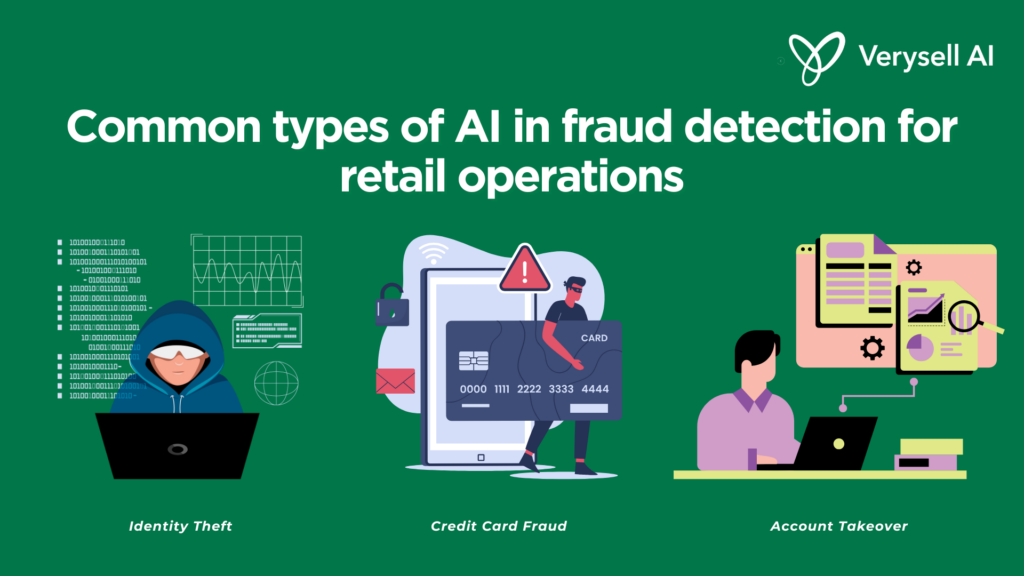AI in fraud detection for retail operations has become more and more important due to the rise of online shopping and e-commerce to exploit weaknesses in payment systems and steal valuable customer information. Therefore, retailers should utilize AI to enhance their fraud detection capabilities. In this blog post, we will identify the impact of fraud on retail, common types of retail fraud, benefits of AI and key considerations when adapting AI in the retail market.

1. The evaluation of fraud detection
AI-powered fraud detection systems can analyze vast amounts of data in real-time, identifying suspicious patterns and anomalies that may indicate fraudulent behavior. These systems can also adapt to new fraud techniques and learn from past incidents, constantly improving their accuracy and effectiveness.
>> Read more: Future of AI fraud detection in BFSI industry
2. Common types of AI in fraud detection for retail operations
Retail businesses face various forms of fraud, including identity theft, credit card fraud, and account takeover. As fraudsters continuously adapt their strategies, it is essential for businesses to remain vigilant and proactive.

2.1 Identity Theft:
This involves the unauthorized use of personal information, such as names, addresses, and social security numbers, to make fraudulent purchases or open accounts. Identity theft can be particularly damaging, not only impacting the individuals targeted but also harming the reputation of the businesses involved.

2.2 Credit Card Fraud:
Credit card fraud occurs when stolen or counterfeit credit cards are used for unauthorized transactions. With the rise of online shopping, fraudsters have discovered new ways to exploit vulnerabilities in payment systems, making it critical for businesses to implement strong security measures to safeguard their customers’ financial information.

2.3 Account Takeover:
Account takeover refers to fraudsters gaining unauthorized access to a customer’s account and making changes or transactions without permission. This type of fraud can have serious repercussions for both the customer and the business, leading to financial losses and diminishing trust in the business’s ability to protect sensitive information.

To address these fraud risks, retail businesses must invest in advanced fraud detection and prevention systems. These systems utilize sophisticated algorithms and machine learning techniques to identify suspicious activities and flag potentially fraudulent transactions in real time. By proactively detecting and mitigating fraud, businesses can protect themselves and their customers from the severe consequences of retail fraud.
3. Benefits of AI in fraud detection
The adoption of AI provides numerous advantages to retail businesses, extending beyond mere detection and prevention of fraudulent activities. Here are some key benefits:
3.1 Speed and Efficiency in Fraud Detection
AI systems can analyze vast amounts of data in real time, allowing retailers to quickly identify fraudulent activities. In contrast, traditional methods often involve time-consuming manual reviews, which can delay the identification of potential threats. By automating the fraud detection process, AI significantly reduces response times, enabling retailers to take swift action and minimize the impact of fraud.
3.2 Enhancing Accuracy and Reducing False Positives
Conventional fraud detection systems frequently generate false positives, mistakenly flagging legitimate transactions as potentially fraudulent. These false alarms can inconvenience customers and disrupt business operations. AI-based fraud detection systems enhance accuracy by analyzing large datasets and identifying patterns, thereby reducing the occurrence of false positives. This improvement leads to a better customer experience and more streamlined operations.
4. Implementing AI in Retail Businesses for Fraud Detection
While the advantages of AI are evident, implementing an AI-based system requires careful planning and consideration. Here are some key steps retailers should follow:
4.1 Assess Current Systems
AI for retail operations evaluate existing fraud detection processes to identify gaps and areas for improvement. This assessment should include an analysis of current technologies, methods, and response times to highlight areas needing improvement. Understanding these gaps is essential for developing a more robust fraud prevention strategy. Additionally, engaging with stakeholders involved in fraud detection can provide valuable insights into the practical challenges faced on the ground.
4.2 Define Objectives
Clearly outline the goals of implementing AI, such as reducing response times, minimizing false positives, or enhancing overall security. Setting measurable objectives will provide a clear direction for the AI integration process. These goals should align with the broader business strategy to ensure comprehensive support. These objectives should be aligned with the broader business strategy to ensure that the AI implementation supports organizational goals. By setting specific targets, such as a 30% reduction in fraud response times within six months, businesses can track progress and make informed adjustments along the way.
4.3 Choose the Right Technology
Select AI tools and algorithms that best fit the unique needs of the business and the types of fraud being targeted. Consider factors such as scalability, ease of integration, and compatibility with existing systems. The right technology will enhance the effectiveness of efforts and provide a solid foundation for future advancements. Investing in robust technology will not only enhance immediate fraud detection efforts but also lay a solid foundation for future advancements and adaptations as fraud tactics evolve.
4.4 Integrate with Existing Systems
Ensure that the AI solution can seamlessly integrate with current systems and processes for efficient operation. This integration is crucial for maintaining data flow and operational efficiency. Properly aligning the new technology with existing infrastructure will help maximize its impact on fraud detection. Collaborating with IT teams during this phase can help identify potential challenges and streamline the integration process, ultimately maximizing the AI solution’s impact on fraud detection.
4.5 Training staff
Provide training for staff to effectively use the new AI tools and understand the insights generated by the system. Empowering employees with knowledge will enhance their ability to respond to potential fraud incidents proactively. Ongoing training and support will help maintain high performance as the technology evolves. Empowering employees with knowledge enhances their ability to proactively respond to potential fraud incidents. Additionally, establishing a culture of continuous learning through ongoing training and support will help maintain high performance as the technology and fraud landscape evolve.
4.6 Monitor and Optimize
Continuously monitor the performance of the AI fraud detection system and make necessary adjustments to improve accuracy and effectiveness. Regularly analyzing system outputs and user feedback will allow for timely adjustments to enhance accuracy and effectiveness. This iterative approach will ensure that the system remains responsive to evolving fraud tactics and maintains optimal performance. Regularly scheduled reviews and updates will keep the system aligned with the evolving needs of the business and its customers.
5. Conclusion
In conclusion, AI has emerged as a game-changer for retail businesses. By leveraging the power of AI, retailers can enhance their ability to detect and prevent fraudulent activities, protecting both their assets and their valuable customers. It will continue to play a pivotal role in combating fraud and ensuring a secure and trustworthy retail environment. Contact us to explore the role of AI for retail operations.


